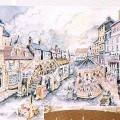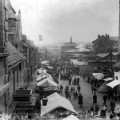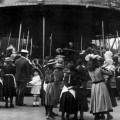Loughborough Town Fair
3 March 2015
- The Market Place in the early 1800s . Illustration taken from ‘The Making of Loughborough’ by Don Wix, Wallace Humphrey and Ian Kiel
- Loughborough Fair circa 1894
- Loughborough Fair circa 1890s
The majority of fairs in Britain trace their history back to the medieval period and beyond, and Loughborough’s fair is no exception. Markets and fairs as centres of trade, commerce and entertainment have been held in Loughborough for well over 700 years.
The original Charter was granted to Loughborough in 1221 for an annual fair held on the 31st of July. Seven years later this was extended to include three days around the Feast of St Peter on the 29th June, with a third Charter for a fair on the Feast of All Souls in November granted to Hugh le Despencer, Lord of the Manor of Loughborough, in 1228. The Charter enabled the Lord of the Manor to organise and regulate the fair in return for revenue collected from stall holders.
November hiring fairs, also known as statue or ‘mop fairs’, can be traced to 1351 when Edward III passed legislation to regulate a labour force reduced to low levels by the plague. Traditionally, male and female workers attended these fairs to offer their services to employers for the coming year. The November fair in Loughborough came into existence for just such a purpose and continued until the end of the 19th century.
Around a hundred show people bring their rides, amusements and refreshment stalls to Loughborough Fair each year, which falls at the end of their travelling calendar. Families such as the Collins, the Proctors and the Hollands have been part of the travelling community for generations and many remain in the area over the winter period.
Detailed information on the history of fairs, including the annual fair in Loughborough, can be found on Sheffield University’s National Fairground Archive. The site includes photographs taken of Loughborough Fair during the late 1950s and early 1960s.
Additional information for this feature was sourced from the Charnwood Borough Council website.
You can watch a video walk-through of Loughborough Fair recorded in November 2013.


